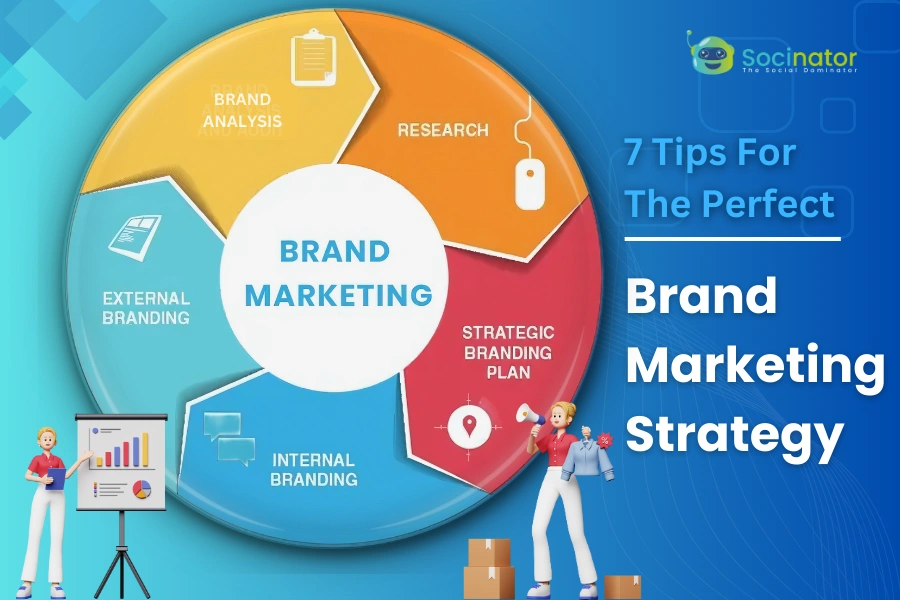Are your marketing efforts falling flat? If so, this blog is designed just for you. Developing a successful brand marketing strategy is challenging in today’s digital age, where countless brands compete for consumer attention. It’s the difference between losing your brand in the crowd and establishing itself as a trusted leader.
To help you navigate the ever-evolving marketing landscape, we’ve compiled seven powerful tips that will assist you in creating the best brand advertising strategy possible.
This comprehensive guide will illuminate the key steps to take and empower you to develop a tactic that resonates with your target audience and propels your brand toward remarkable success. So, get ready to discover the secrets to crafting a marketing strategy that’s as captivating as it is effective!
But before diving deeper, it is vital to understand brand marketing first. So, let us begin.
Hit ‘Play’ Button & Tune Into The Blog!
What Is Brand Marketing?
Brand marketing is a method of promoting your products or services by projecting your entire brand. It tells the story of what you offer by focusing on the brand.
Branding means using a name, term, design, symbol, or other feature to identify your product or service and make it stand out. A strong brand connects with your buyers emotionally, turning them into loyal customers.
It is all about creating a unique and recognizable identity and sharing it with the market. The key to branding is to form an emotional connection with your customers by consistently delivering messages that resonate with them. The goal is to build loyalty and trust so customers keep coming back.
To elevate brand marketing, you must clearly understand what potential customers expect from your brand. It means approaching branding as a problem-solving activity, finding ways to meet your customers’ needs and desires. With this understanding, you can create messages that speak directly to them, helping to form an emotional connection and making your brand more memorable.
Example Of Branding:
To see the power of brand marketing, let’s see one of the most popular electronics companies- Apple. Nowadays, who isn’t familiar with Apple’s products? The company has built such a strong brand image that its products are universally recognized.
But how did Apple build such a strong brand? They focused on three key aspects: what the product is, what it does, and how to use it.
First, Apple ensures that its products are always high quality and innovative. They consistently release new products that people want, like the hugely popular iPhone when it first launched.
Second, they make their products easy to use and understand. Instead of overwhelming consumers with information, they keep everything simple and user-friendly.
Lastly, they create an overall enjoyable experience for their customers. Everything about Apple makes you feel good, from the sleek design of products to the way of creating their ads.
By combining these elements, it must be now clear why Apple has such a strong brand. But what is the significance of a brand in marketing? Let us learn about it.
What Is A Brand In Marketing?
 In marketing, a brand refers to a product or service having a distinctive and easily identifiable identity, setting it apart from others in its sector. Consumers associate the product name, label, and packaging with specific qualities such as value, quality, or sophistication.
In marketing, a brand refers to a product or service having a distinctive and easily identifiable identity, setting it apart from others in its sector. Consumers associate the product name, label, and packaging with specific qualities such as value, quality, or sophistication.
But why do consumers prefer to buy specific brands even though many similar products exist in the market? Consumers prefer specific brands due to brand loyalty, perceived quality, familiarity, brand image, effective marketing, customer service, loyalty programs, and social proof, all of which create stronger connections and trust.
For example, all mobile phones serve a similar function, the decision to purchase a particular brand, such as Apple, Samsung, or Nokia, is often influenced by the message communicated by that brand. As a result, consumers are guided by this message to choose brands that correspond to their unique values, qualities, or promises.
Let us now explore the significance of brand marketing.
Importance Of Branding In Today’s World:
Branding goes beyond just a logo; it encompasses the overall look and feel of the company, including its values, mission statement, and reputation. Grasping its importance is crucial, as it combines elements such as:
Branding Enhances Value:
A strong brand enhances business value by fostering customer loyalty and encouraging repeat purchases. It enables businesses to justify premium pricing for their products and services, as consumers are willing to invest in trusted brands.
Brand Marketing Establishes Distinction:
In today’s competitive market, businesses must distinguish themselves from competitors. Establishing a unique brand identity allows businesses to create a lasting impression on consumers. Effective branding fosters an emotional connection with customers, fostering loyalty and a competitive advantage. With proper social media branding strategies, businesses gain an advantage over their competitors in improving their branding.
Branding Fosters Unity And Action:
A robust brand can unite people around a shared cause or product, especially when supporting social or environmental initiatives. A business can inspire collective action and encourage customer engagement by solidifying its brand identity. This cohesion can drive sales growth and foster a devoted customer base.
Based on the points discussed above, we grasp its significance. This naturally leads to another question: what is the primary objective of branding? We will address this query in the next section.
Core Objectives Of Brand Marketing:
It sets up a framework for businesses to establish and maintain their brand amidst dynamic and competitive environments. These include defining your brand identity, increasing brand recognition, and fostering brand loyalty. Let us learn about it in brief.
Increasing Brand Visibility:
Once a robust brand identity is established, the next priority is to spread the brand’s mission and values to enhance awareness. It requires implementing targeted marketing strategies across diverse channels and messaging platforms. These strategies may include organizing impactful events, launching strategic digital advertising campaigns, curating compelling content, and leveraging influencer partnerships and utilizing viral marketing techniques to boost reach.
Each initiative should seamlessly align with the brand’s core identity, ensuring consistent and impactful efforts to increase visibility and engagement among the target audience.
Developing Brand Loyalty:
In any brand marketing strategy, building brand loyalty is a critical goal. Beyond increasing brand recognition, businesses must aim to convert potential customers into loyal advocates. It involves deploying tactics that cultivate customer relationships, forge emotional bonds, and instill trust.
Achieving this requires delivering outstanding customer service, offering regular promotions that resonate, and providing personalized interactions. Moreover, leveraging social media initiatives, tailored email campaigns, and loyalty programs can nurture and sustain brand loyalty.
You can get assistance from a social media automation tool like Socinator to leverage social media easily to improve your marketing strategy.
Creating Your Brand Identity:
 Crafting a unique and compelling brand identity is the cornerstone of any successful brand strategy. This identity distinguishes businesses in a competitive landscape and enables targeted consumer engagement. Establishing an effective brand identity entails selecting a fitting name, tagline, logo, and, crucially, a distinct message that expresses the brand’s mission and values.
Crafting a unique and compelling brand identity is the cornerstone of any successful brand strategy. This identity distinguishes businesses in a competitive landscape and enables targeted consumer engagement. Establishing an effective brand identity entails selecting a fitting name, tagline, logo, and, crucially, a distinct message that expresses the brand’s mission and values.
A cohesive, memorable brand identity facilitates customer acquisition, fosters loyalty among current customers, and motivates employees to align with the brand’s overarching goals.
Next, we will explore seven tips for crafting an effective strategy.
Seven Steps to Crafting an Optimal Brand Marketing Strategy:
 Effective brand marketing strategies are essential to ensure customer recognition and brand association. Explore these fundamental steps to develop a comprehensive tactic from the ground up. Let us go through them.
Effective brand marketing strategies are essential to ensure customer recognition and brand association. Explore these fundamental steps to develop a comprehensive tactic from the ground up. Let us go through them.
Conduct A SWOT Analysis:
A SWOT (Strengths, Weaknesses, Opportunities, Threats) analysis is fundamental in developing a marketing strategy. This assessment offers a clear understanding of the company’s present standing and the external factors impacting it.
The analysis equips marketing teams to make well-informed decisions and foresee market shifts by pinpointing potential risks and opportunities. Ultimately, leveraging the insights from a SWOT analysis empowers businesses to plan and implement impactful campaigns.
Define the Value Proposition:
Following the SWOT analysis, the next step is to define the value proposition. All marketing efforts should convey the central promise of a product or service.
It highlights the unique qualities of the company’s offerings and demonstrates how they can enhance the customer’s experience. By crafting and effectively conveying a compelling value proposition, businesses can engage their target audience and establish a successful brand marketing strategy.
Define Marketing Strategy Goals:
In crafting a branding strategy, the third step involves setting precise objectives. These goals guide marketing efforts and act as benchmarks to measure their impact.
Emphasizing SMART criteria—Specific, Measurable, Achievable, Relevant, and Time-bound—is essential to ensure goals are clearly defined and actionable. This approach helps businesses align their strategies with strategic outcomes and optimize their marketing effectiveness.
Gain Customer Insights:
Understanding the customer base is the fourth step in developing a successful marketing strategy. It involves critical research into customer behaviors and preferences and effectively customizing content and messaging in marketing campaigns.
A company’s marketing efforts should match its target customers, market segments, and changing customer trends.
Create Buyer Personas:
The fifth step involves developing buyer personas. These personas are informed by market research and represent fictionalized versions of customers.
They offer valuable insights into customer needs, motivations, and behaviors, guiding the marketing strategy and content development. Creating detailed buyer personas enables companies to tailor their messages effectively, resonating more deeply with their target audience.
Conduct Market and Competitor Analysis:
 The sixth step in crafting an effective brand marketing strategy requires comprehensive market and competitor analyses. It involves evaluating current market trends, understanding the composition of the existing customer base, and assessing the competitive landscape.
The sixth step in crafting an effective brand marketing strategy requires comprehensive market and competitor analyses. It involves evaluating current market trends, understanding the composition of the existing customer base, and assessing the competitive landscape.
Insights gleaned from these analyses inform strategic decision-making in marketing, improving the alignment of initiatives with market needs and preferences. By gaining a deeper understanding of these dynamics, businesses can optimize their strategies to achieve their objectives and gain a competitive edge in the marketplace.
Define Your Marketing Channels:
The final phase entails carefully determining the marketing channels to deploy. This critical step involves selecting the most suitable platforms, channels, and strategies to connect with customers efficiently.
Companies must conduct a thorough evaluation to align these choices with their specific goals, financial considerations, and the preferences of their target audience. By doing so, businesses can ensure their marketing efforts are effective and resonate effectively, fostering meaningful engagement and communication.
Three Mistakes to Steer Clear of When Crafting a Brand Marketing Strategy:
 When creating a brand marketing strategy, be sure to steer clear of these common pitfalls:
When creating a brand marketing strategy, be sure to steer clear of these common pitfalls:
Not Analyzing Your Competitors:
Imagine developing a strategy and launching your campaigns, only to discover that a competitor has already executed a similar approach. This scenario is common and can be avoided by thoroughly researching your industry and understanding what your competitors are doing before you begin. This due diligence ensures a unique strategy and sets you apart.
Failing To Establish A Long-Term Vision:
Without clear objectives and a defined brand mission, your brand marketing strategy will lack focus and direction. It’s crucial to establish long-term goals, not just short-term ones. One long-term objective might be to expand into international markets, launch new products, or establish a substantial social media presence. Having a long-term vision ensures your strategy is cohesive and purpose-driven.
Maintaining Inconsistent Creativity:
Different creative approaches for each marketing communication can confuse your audience and damage your brand. Consistency is key. For example, a burger chain shouldn’t simultaneously run a celebrity endorsement video and an animated ingredients ad. Maintain a uniform brand voice across all channels to ensure your audience can easily recognize and connect with your brand.
Consistency is the key to promoting your brand effectively. To maintain consistency throughout all your social media profiles, you can utilize a social media automation tool. One such tool is Socinator. It’s a powerful tool designed to ignite social media success through seamless automation, targeted marketing, and dynamic growth.
Let us learn about this tool briefly.
Socinator- Unlock Your Social Media Potential With The Best Automation Tool
 Socinator is a powerful automation tool designed to streamline your social media content planning and management. It enables you to oversee multiple social media accounts, including Facebook, Instagram, Twitter, YouTube, Quora, Pinterest, LinkedIn, Reddit, and Tumblr, all from one centralized dashboard.
Socinator is a powerful automation tool designed to streamline your social media content planning and management. It enables you to oversee multiple social media accounts, including Facebook, Instagram, Twitter, YouTube, Quora, Pinterest, LinkedIn, Reddit, and Tumblr, all from one centralized dashboard.
It is an ideal tool for busy individuals unable to manage their profiles manually.
Socinator offers features like:
Auto Like And Comment: Socinator offers automatic liking and commenting features, enabling users to engage with their audience effortlessly. It improves interaction and improves visibility throughout the social media platforms.
Post Scheduling: Users can schedule posts in advance, ensuring timely and consistent content delivery. This feature is invaluable for maintaining a regular posting schedule and reaching audiences at optimal times.
Broadcast Messages: Efficient broadcasting capabilities allow for streamlined messaging campaigns, reaching a wider audience with minimal effort.
Auto Reply: Automated responses to new messages ensure prompt and personalized interaction with followers, enhancing customer satisfaction and engagement.
User Targeting: Socinator’s ability to identify and gather engaged and targeted users helps businesses build meaningful connections and grow their follower base strategically. This feature supports targeted marketing efforts and enhances overall social media effectiveness.
It is one of the best social media automation tools that streamlines social media marketing, making it efficient and easy. With this tool, you can easily automate your Twitter and YouTube marketing.
Let us go through some of the three best branding strategies in the business.
Also Read:
Top 7 Social Media Branding Strategy For Your Business
5 Remarkable Marketing Campaigns for Your Brand
7 Secrets To Master Your Social Media Personal Branding Game
Three Of The Most Effective Brand Marketing Strategies In The Industry:
Apple, McDonald’s, and Nike are globally recognized brands that have achieved widespread familiarity through successful marketing strategies. Let us study these strategies briefly.
Mcdonald’s Strategy For Brand Marketing:
 McDonald’s is widely recognized globally as one of the most iconic brands. Their approach depends on preserving a uniform brand identity. The golden arches symbolize happiness and are instantly identifiable across continents, from America to India and Australia.
McDonald’s is widely recognized globally as one of the most iconic brands. Their approach depends on preserving a uniform brand identity. The golden arches symbolize happiness and are instantly identifiable across continents, from America to India and Australia.
McDonald’s has achieved this by preserving their brand identity and product consistency for over six decades while making thoughtful and on-brand enhancements. Their marketing messages consistently revolve around bringing happiness to customers, and their logo remains largely unchanged. Over the years, slogans like, “You deserve a break today” “That’s my McDonald’s”, and “I’m lovin’ it” have reinforced this message.
When developing a strategy, prioritize longevity. Avoid unnecessary reinvention, which may result in confusion and disconnect with your audience. Consistency and thoughtful evolution are vital in maintaining a sturdy and enduring brand presence.
Apple’s Approach To Brand Marketing:
 Apple’s brand marketing strategy is simple: they don’t just sell products- they spark movements. Each Apple marketing campaign goes beyond highlighting devices; it promotes a way of life. From their iconic white packaging to impactful slogans like “Think Different” Apple creates a narrative that convinces consumers their products are essential for a better life.
Apple’s brand marketing strategy is simple: they don’t just sell products- they spark movements. Each Apple marketing campaign goes beyond highlighting devices; it promotes a way of life. From their iconic white packaging to impactful slogans like “Think Different” Apple creates a narrative that convinces consumers their products are essential for a better life.
This approach has cultivated a loyal fan base. Apple understands the loyalty of its fans and maintains a consistent brand image that is both modern and innovative, even as its marketing tactics evolve.
Nike’s Method Of Brand Marketing:
 Nike’s approach extends beyond just selling products—it centers on narratives. Across their website, product descriptions, and social media, Nike consistently weaves stories about their products, origins, and inspirations.
Nike’s approach extends beyond just selling products—it centers on narratives. Across their website, product descriptions, and social media, Nike consistently weaves stories about their products, origins, and inspirations.
Whether through sharing your business journey or providing background, incorporating storytelling into your brand humanizes your business. This approach can effectively engage customers by creating relatable connections. Your brand narrative does not need to be revolutionary; offering insights into your origins and values can be more impactful than simply promoting products.
Conclusion:
A successful brand marketing strategy hinges on a trifecta of elements- consistent brand identity, audience-centric storytelling, and a deep understanding of your target market. Industry giants like Apple, McDonald’s, and Nike exemplify the power of this approach, leveraging these principles to cultivate global recognition and unwavering customer loyalty.
Companies can build stronger relationships with their target customers by sustaining a consistent brand image, crafting engaging stories, and adapting swiftly to market changes. Ultimately, a well-defined marketing strategy transcends mere brand awareness; it fosters enduring customer relationships, propelling sustainable growth in the ever-competitive digital landscape.
By embracing these core principles, you can propel your brand towards long-term success in the digital age.
Brand Marketing FAQs
What Is Brand Building?
Brand building in brand management focuses on improving a brand’s perception, reputation, and overall image. These efforts typically aim to boost recognition and familiarity with the brand.
What Are The Three Cs Of Brand Marketing?
The fundamental principles of branding, known as the three Cs—clarity, consistency, and constancy—emphasize that successful brands clearly define their identity and unique value proposition while maintaining a steady and unified presence.
What Is The Scope Of Branding?
Effective branding educates consumers about the target audience, the product’s functionality, and its superiority compared to alternatives. Branding isn’t limited to physical products and services. It also encompasses individuals, locations, institutions, and concepts.






